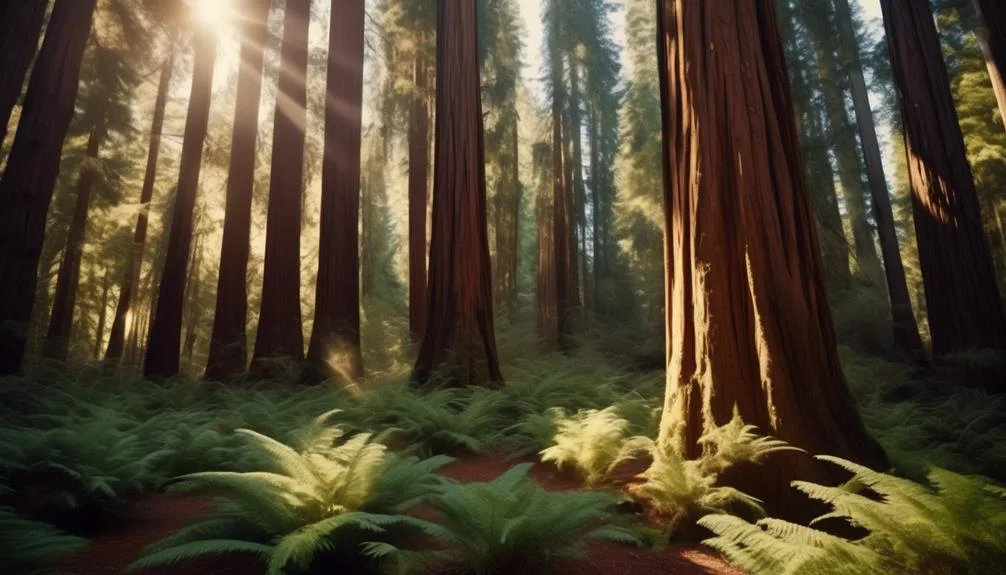The distinctive conical shape of redwood trees isn't just for looks. It's the result of genetic adaptation and environmental factors that have shaped these giants over time.
But why do they have this form? The answer lies in a blend of biological and ecological principles that have allowed these trees to thrive in their unique habitat.
Understanding the mystery behind their shape gives us a newfound appreciation for nature's balance and the remarkable adaptations of redwoods.
Genetic Adaptation
Redwood trees' conical shapes are a result of genetic adaptation, allowing them to efficiently capture sunlight and withstand strong winds in their native habitats. This evolutionary advantage is a result of natural selection, where only the trees with the most advantageous traits, such as the conical shape, survived and passed on their genes.
The conical shape enables the trees to capture sunlight more effectively, as the sloping branches ensure that each level of the tree receives an optimal amount of sunlight. Additionally, this shape helps the trees withstand strong winds, reducing the impact on the tree and preventing breakage.
This genetic adaptation has provided redwood trees with a significant advantage in their environment, contributing to their survival and dominance in their native habitats.
Environmental Factors
In their native habitats, redwood trees interact with a variety of environmental factors that shape their growth and survival. These factors include:
- Climate influence, tree growth: The cool, foggy coastal climate of redwood habitats provides the trees with the moisture they need to thrive. The mild temperatures and high humidity contribute to steady growth, allowing the trees to develop their characteristic conical shape.
- Soil composition, tree shape: Redwoods prefer well-drained, acidic soils high in organic matter. The unique soil composition influences the tree's ability to anchor itself and obtain essential nutrients, ultimately impacting its conical shape.
These environmental factors play a crucial role in the development of redwood trees, shaping their growth patterns and overall conical form.
Efficient Water Transport
Efficiently transporting water throughout the redwood tree is crucial for its growth and survival in its natural environment.
The xylem structure of redwood trees plays a vital role in this process. The xylem consists of specialized cells that form tiny tubes, allowing water to move upwards from the roots to the leaves.
Additionally, the high transpiration rate of redwood trees facilitates efficient water transport. Transpiration is the process of water movement through a plant and its evaporation from aerial parts, such as leaves and stems.
Redwood trees have adapted to maximize this process, ensuring that water is effectively drawn up from the roots and distributed throughout the tree.
This efficient water transport system enables redwood trees to thrive in their unique environment, contributing to their impressive size and longevity.
Light Capture
With their towering presence in the forest, redwood trees are masters at capturing and utilizing light for growth and sustenance. Their unique conical shape plays a crucial role in optimizing light capture, ensuring their survival and dominance in the forest canopy.
Here's how redwood trees excel at light capture:
- Tall Structure: Redwoods grow to incredible heights, maximizing their exposure to sunlight for photosynthesis efficiency.
- Needle-Like Leaves: Their small, needle-shaped leaves provide a large surface area for capturing sunlight and conducting photosynthesis.
- Vertical Arrangement: The leaves are arranged vertically, allowing them to efficiently capture sunlight from various angles throughout the day.
- Carbon Sequestration: By capturing and converting light energy, redwoods play a vital role in carbon sequestration, mitigating the impacts of climate change.
Redwood trees' ability to capture light efficiently and maximize photosynthesis is essential for their remarkable growth and significant carbon sequestration.
Wind Resistance
Redwood trees' mastery of light capture not only fuels their growth but also contributes to their remarkable wind resistance in the forest canopy.
Their conical shape and flexible branches are adaptations honed by tree biomechanics, providing an evolutionary advantage against powerful winds.
The conical shape allows wind to flow around the tree with minimal resistance, reducing the force exerted on the trunk.
Additionally, the flexible nature of their branches enables them to sway with the wind, dissipating its energy and preventing breakage.
This combination of shape and flexibility not only helps the redwoods withstand strong winds but also reduces the risk of toppling over.
This remarkable wind resistance is essential for their survival in the challenging environment of the coastal forests, where strong winds are a frequent occurrence.
Conclusion
In embracing their natural environment, redwood trees have evolved to develop conical shapes, optimizing water transport, light capture, and wind resistance. This adaptation not only ensures their survival but also adds to their captivating presence in the natural world.
How might other species benefit from such finely tuned adaptations?

My interest in trees started when I first saw the giant sequoias in Yosemite.
I was a teenager then, and I remember thinking, “I need to learn more about this.”
That moment stuck with me.
A few years later, I went on to study forestry at Michigan Tech.
Since graduating, I’ve worked in a mix of hands-on tree care and community education.
I’ve spent over ten years helping people understand how to plant, maintain, and protect the trees in their neighborhoods.
I don’t see trees as just part of the landscape.
They are living things that make a real difference in our daily lives.
